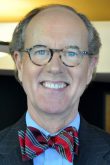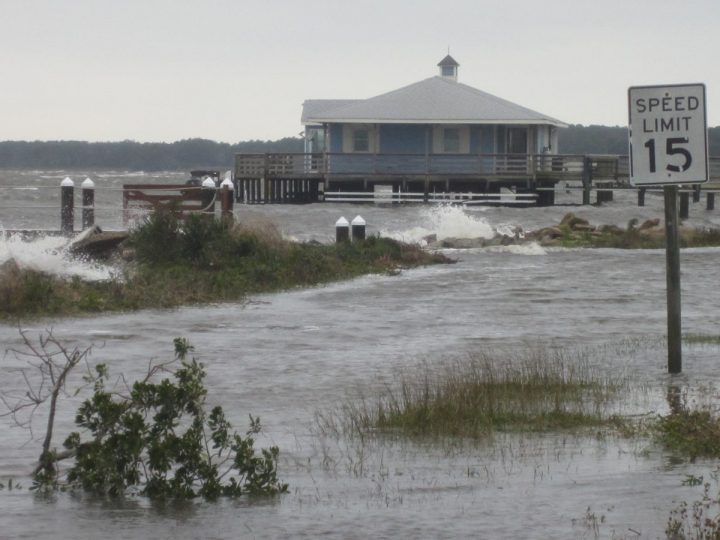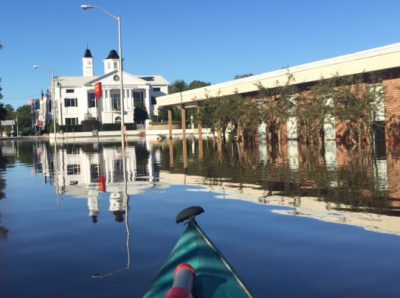NORTHEASTERN N.C. — Conditions in Tyrrell County were in control until late Saturday night, when Hurricane Matthew roared in and dumped a torrent, within hours leaving the entire low-lying county inundated with water coming from every direction.

“You had it all,” county manager David Clegg recounted, reciting a list of sources. “You had Scuppernong River. You had Albemarle Sound. You had rainwater. You had water in ditches. It all mixed together in a cocktail.”
Supporter Spotlight
The rural county, one of the poorest in the state, had barely taken stock of damages wrought by Hurricane Hermine on Sept. 2, when a deluge had flooded fields, yards and roads. Most of those losses were agriculture-related, he said.
Oddly, Clegg said, the flooding from Matthew seemed to take a circuitous route, showing up at unexpected spots and inexplicably leaving places dry where he had expected people to be on rooftops. Residents in their 80s told him they’d never seen any flooding like it before. Thankfully, he says, there were no fatalities – although a few people did have to be rescued by the fire department from rising waters. The National Guard was called in to locate and/or pull people out of remote areas.

It appears, so far, that about one-third of homes and businesses in the county of 3,645 residents have been affected, Clegg said. But many people have not been able to go home yet, so he expected that percentage will ultimately be higher.
Calculation of damage is “an evolving thing,” he said. Half of the county was still without power mid-week. The middle schools and high schools flooded. Farm fields flooded. The county’s social services building and agricultural extension office was flooded, and a tree fell through the roof of the social services building, which already had been flooded by a foot of water.
No one lives in Tyrrell County by mistake, Clegg said. Not only must residents love it, they also must possess the wherewithal to deal with duress.
“You don’t see people standing around saying, ‘Oh me, oh my,’” Clegg said. “You see people standing in the road with a chainsaw.”
All of northeastern North Carolina suffered differing degrees of extreme flooding from rainwater. Rainfall in the coastal plain counties from Matthew ranged between 8 and 15 inches, according to Lara Pagano, a National Weather Service meteorologist in the Newport office.
In Dare County, southern Hatteras Island was inflicted with both a deluge of rain and near-record storm surge during both Hermine and Matthew.

Throughout the rest of the Outer Banks and the Dare County mainland, rainwater, sound tide and ocean overwash flooded roads and yards – at times in seemingly scattershot ways – during Matthew. A series of power poles were knocked down in Nags Head, and numerous roads countywide were closed due to damage or flooding.
On the other side of the Albemarle Sound from Tyrrell, Bertie County was also flooded by rainwater from Hermine and Matthew. But it had suffered an additional deluge in between those storms from Hurricane Julia on Sept. 21.
Although freshwater flooding has been significant, the big concern in Bertie County has been the impact of the rising Cashie River. Up to 10 feet of water flooded roads in Windsor, the county seat, after Julia. The storm dumped more than 12 inches of rain, causing the governor to declare a state of emergency in 11 northeastern North Carolina counties, including Bertie.
Matthew’s deluge inundated the entire county, about 22 miles as the crow flies, but Windsor, as it did in 1999 during Hurricane Floyd and in Julia, took the brunt of it, said Bertie County manager Scott Sauer. The library, the cooperative extension office and beloved Bunn’s Barbeque – in business since 1938 – were flooded, and some streets still have standing water. Fifty-two residents at a local nursing home were evacuated, he says, but there were no fatalities.

Property losses in Julia were $5.1 million, in addition to about $10 million in agricultural losses, Sauer said. Estimates for damage from the latest storm are not completed, he said.

Chowan County was luckier than Bertie and other counties along rivers, said county manager Kevin Howard, mostly because the Chowan River is wider. The county also experienced a little less rainfall, although some roads still washed out.
But most of the effects were seen in the farm fields, which are still under water.
About half of Chowan County’s 110,460 acres are farmland, said Matthew Leary, the county’s agriculture extension agent. Crops – mostly peanuts, cotton and clary sage, followed by soybeans and some wheat and corn – are expected to suffer losses of 20 percent to 50 percent.
“I think most of the fields will be harvestable,” Leary said.
Crop losses from Julia and Hermine ranged from $2.5 million to $4 million in gross revenue, he said. According to the 2012 census, there are about 141 farms in Chowan County.
With Matthew, the Cashie crested on Sunday and early Monday, with a high level of 16.6 feet, said Bill Sammler, National Weather Service meteorologist in Wakefield, Virginia.

That’s just two feet below the level set in Hurricane Floyd, which stands as the worst flooding event in state history. And that is close to, or a bit higher, than what was experienced during Julia, he said, which lasted for four days.
Sammler said that river flooding in the northeast has so far not been as bad as after Floyd, but “it’s close.” And in some areas in the region, it may end up being worse, possibly in Camden and Pasquotank counties.
Also, the Tar River is expected to crest this week in Greenville and create widespread serious flooding. Other cities and towns may suffer continuing damage from rising waters in the Neuse and Tar rivers and their tributaries.
Julia’s rain amounts were higher north of the Albemarle Sound, he explained, and Hermine dropped much more rain on the coast.

By the time Matthew came around, a lot of places were already soaked, putting them at risk of flooding much more quickly.
“We really saw very little flooding with Hermine,” Sammler said, “and to a large extent, that is because we’d been dry for four to six weeks.”
At least 32 counties are eligible to receive federal storm recovery funds, including in the northeast region: Beaufort, Bertie, Camden, Chowan, Currituck, Dare, Hyde, Pasquotank, Perquimans, Pitt, Tyrrell and Washington counties.








